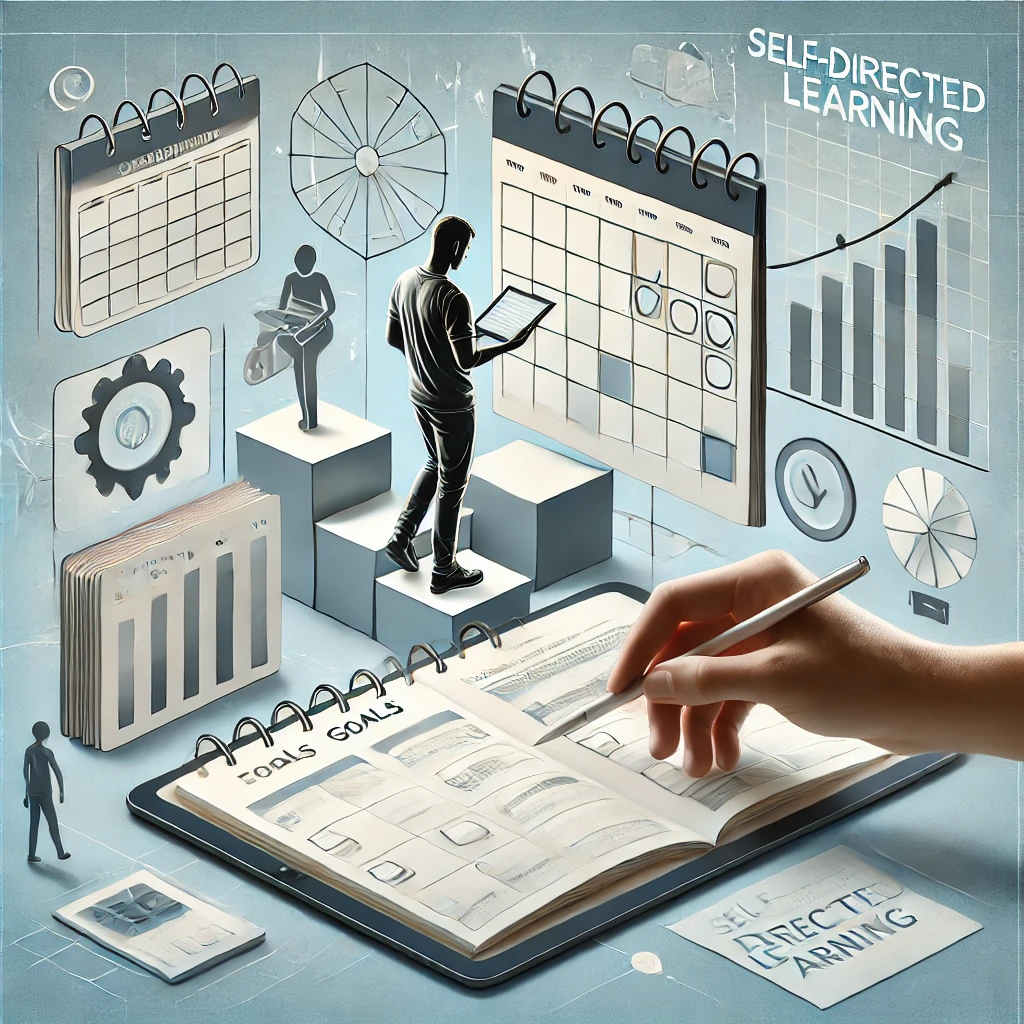Spotlight content
In today’s fast-changing job market, the developing continuous learning skills is no longer just a bonus; it’s essential. Professionals who can quickly adapt to new challenges and acquire skills on the go are landing the high-paying roles of 2024. Gone are the days when simply mastering one technical skill guaranteed career longevity. Instead, employers are increasingly seeking candidates who can demonstrate a commitment to lifelong learning and who possess the adaptability to thrive in evolving industries.
In this article, we’ll dive into six continuous learning techniques that are in high demand, helping you position yourself for high-salaried roles in 2024. Whether you’re a student, a lifelong learner, or a seasoned professional, these strategies will set you apart from the competition.
Embracing the Growth Mindset: Your Ticket to High-Salaried Roles
At the heart of continuous learning lies the growth mindset – a concept popularized by psychologist Carol Dweck. But what exactly is a growth mindset, and why is it crucial for your career success?
A growth mindset is the belief that your abilities and intelligence can be developed through effort, learning, and persistence. It’s the opposite of a fixed mindset, which assumes that our character, intelligence, and creative ability are static givens that we can’t change in any meaningful way.
In the context of your career, adopting a growth mindset means viewing challenges as opportunities to learn and grow, rather than insurmountable obstacles. It’s about embracing feedback, seeing effort as a path to mastery, and finding lessons and inspiration in the success of others.
Real-world application: Resilience in the Face of Change
In today’s rapidly evolving job market, a growth mindset is your secret weapon. It fosters resilience and adaptability – two qualities that employers in high-paying roles increasingly value. When you approach your career with a growth mindset, you’re more likely to:
- Take on new challenges without fear of failure
- Persist in the face of setbacks
- Seek out learning opportunities, even when they’re uncomfortable
- Adapt more quickly to changes in your industry or role
Practical Example: From Traditional Marketing to Tech Leadership
Consider the story of Sarah, a traditional marketing professional who found herself at a crossroads when her company began shifting towards digital-first strategies. Instead of resisting the change or fearing obsolescence, Sarah embraced it as an opportunity to grow.
She started by taking online courses in digital marketing and data analytics. When she struggled with certain concepts, instead of getting discouraged, she reminded herself that struggle is a natural part of learning. She sought out mentors in the tech side of the business and volunteered for projects that would stretch her digital skills.
Within two years, Sarah had not only adapted to the new digital landscape but had become a leader in her company’s digital transformation efforts. Her growth mindset led her to a promotion to Chief Digital Officer – a high-salaried role that didn’t even exist when she started her career.
“In the age of AI, uniquely human abilities like empathy and creativity are your greatest assets.”

The Power Duo: Blending Soft and Technical Skills
While technical skills often take the spotlight in discussions about career advancement, the truth is that soft skills are equally crucial – especially as we move into an era where AI and automation are becoming more prevalent in the workplace.
Research from Pearson emphasizes that the future workforce must balance technical expertise with soft skills like communication, adaptability, and leadership. As AI takes over more routine tasks, it’s our uniquely human abilities that will set us apart and command higher salaries.
Real-world application: Standing Out in a Tech-Driven World
In practice, blending soft and technical skills makes you a more well-rounded and valuable professional. Here’s why:
- Technical skills allow you to perform specific job functions efficiently.
- Soft skills enable you to work well with others, lead teams, and navigate complex workplace dynamics.
- The combination of both allows you to not only do your job well but also communicate its value, collaborate effectively, and drive innovation.
Practical Example: The Data Scientist Who Became a Leader
Let’s look at the case of Alex, a data scientist at a large tech company. Alex was brilliant with numbers and could create complex algorithms in their sleep. However, they struggled to explain their findings to non-technical team members, which limited the impact of their work.
Recognizing this, Alex decided to focus on developing their communication and leadership skills alongside their technical expertise. They joined Toastmasters to improve their public speaking, took a course on data visualization, and volunteered to lead cross-functional projects.
The result? Alex’s ability to translate complex data insights into actionable business strategies caught the attention of senior leadership. Within 18 months, they were promoted to Head of Data Strategy, a high-salaried role that required both technical depth and the ability to lead and influence across the organization.
Learning Agility: Your Secret Weapon in a Changing Workplace
In a world where the half-life of skills is rapidly decreasing, learning agility has become one of the most sought-after qualities in high-salaried roles. But what exactly is learning agility?
Learning agility is the ability to quickly learn, unlearn, and relearn based on new experiences and information. It’s about being able to rapidly adapt to new situations, technologies, and methodologies – a crucial skill in today’s fast-paced business environment.
A 2022 Deloitte study found that individuals with high learning agility often take on leadership roles, as they help organizations adapt to change more effectively. They’re the professionals who thrive in ambiguity and see change not as a threat, but as an exciting challenge.
Real-world application: Staying Relevant in a Fast-Changing Industry
In practice, learning agility manifests as:
- Quickly picking up new skills or technologies as they emerge in your field
- Being able to apply knowledge from one area to solve problems in another
- Remaining effective in your role even as job requirements evolve
- Anticipating changes in your industry and proactively upskilling
Practical Example: The Marketing Professional Who Rode the Digital Wave
Consider Maria, a marketing professional who started her career in traditional advertising. As digital marketing began to dominate the industry, many of her colleagues struggled to adapt. But Maria’s learning agility allowed her to not just keep up, but to excel.
She immersed herself in digital marketing courses, experimented with new platforms as they emerged, and wasn’t afraid to learn from younger, more digitally-native team members. When social media marketing took off, Maria was one of the first in her company to recognize its potential and develop expertise in this area.
Her ability to quickly master new digital tools and strategies made her an invaluable asset to her company. As a result, she was promoted to Chief Marketing Officer, a high-salaried role that required the perfect blend of traditional marketing wisdom and cutting-edge digital expertise.

Microlearning: Bite-Sized Learning for Busy Professionals
In our fast-paced work environments, finding time for continuous learning can be challenging. This is where microlearning comes in – a technique that’s gaining traction in corporate learning environments.
Microlearning involves consuming content in small, specific bursts, each focused on a single learning objective. These bite-sized learning modules, often delivered through platforms like Degreed or LinkedIn Learning, can be easily integrated into your daily routine.
A 2020 study on microlearning showed a 17% improvement in knowledge retention compared to traditional training methods. Despite its effectiveness, many organizations and individuals have yet to fully embrace this learning technique.
Real-world application: Continuous Learning Without the Time Crunch
Here’s how you can apply microlearning in your professional life:
- Use your commute time to listen to short educational podcasts
- Dedicate 15 minutes each day to complete a module on a learning platform
- Watch brief instructional videos during your lunch break
- Use mobile apps that offer quick lessons or quizzes in your field
Practical Example: The Busy Executive Who Learned a New Language
Take the case of John, a senior executive in a global company. He needed to learn Mandarin for an upcoming expansion into the Chinese market, but his packed schedule made traditional language classes impossible.
John turned to microlearning, using a language app that offered 5-minute lessons. He completed lessons during short breaks in his day – while waiting for his coffee, before meetings, or even in the elevator. By consistently dedicating small pockets of time to learning, John was able to achieve conversational fluency in Mandarin within six months, impressing both his team and Chinese partners.
This newfound skill not only helped John lead the expansion successfully but also positioned him for a promotion to a global leadership role with a significant salary increase.
Peer-Led Learning: Tapping into Collective Intelligence
While formal training has its place, some of the most valuable learning experiences come from our peers. Peer-led learning programs, where employees teach and learn from each other, are showing promising results in fostering a learning culture.
A 2021 MIT study found that when employees are encouraged to teach their colleagues, they deepen their own understanding by up to 50%. Despite its effectiveness, this approach is still underutilized in many corporate environments.
Real-world application: Creating a Learning Ecosystem
Here’s how you can incorporate peer-led learning into your professional development:
- Initiate or join a skills-sharing group within your organization
- Offer to give a presentation on your area of expertise to your team
- Seek out mentorship opportunities – both as a mentor and a mentee
- Participate in or organize “lunch and learn” sessions
Practical Example: The Tech Company That Transformed Its Culture
Consider TechInnovate, a mid-sized software company that was struggling with knowledge silos and a lack of cross-departmental collaboration. They implemented a peer-led learning program called “Teach & Grow.”
Every month, employees would volunteer to teach a skill to their colleagues. Sessions ranged from coding workshops led by developers to design thinking seminars run by UX designers, and even mindfulness classes taught by HR professionals.
The results were transformative. Not only did employees gain new skills, but the program also broke down departmental barriers, fostered innovation, and significantly improved employee engagement. The company saw a 30% increase in internal promotions, with many employees moving into higher-paid, cross-functional roles.

Reflective Learning: Turning Experience into Expertise
In the rush to acquire new skills, we often overlook one of the most powerful learning tools at our disposal: reflection. Reflective learning involves thoughtfully considering our experiences and extracting lessons that can be applied to future situations.
While not as flashy as some other learning techniques, reflection is crucial for developing deep expertise and wisdom – qualities that are highly valued in senior, high-salaried roles.
Real-world application: Learning from Every Experience
Here’s how you can incorporate reflective learning into your professional life:
- Keep a work journal to record key experiences and lessons learned
- Schedule regular “reflection time” in your calendar
- After completing a project, conduct a personal post-mortem
- Seek feedback from colleagues and thoughtfully consider their input
Practical Example: The Manager Who Became a Respected Leader
Let’s look at the story of Priya, a mid-level manager who aspired to an executive role. While she had strong technical skills, she struggled with team dynamics and conflict resolution.
Priya decided to make reflective learning a priority. After every team meeting and one-on-one, she spent 10 minutes jotting down what went well, what could have gone better, and what she learned. She also started asking for regular feedback from her team and her superiors.
Over time, this practice helped Priya develop exceptional emotional intelligence and leadership skills. She became known for her ability to navigate complex team dynamics and bring out the best in her people. Within two years, Priya was promoted to an executive role, doubling her salary and influencing company-wide policies.
Conclusion: Your Roadmap to Continuous Learning Success
As we’ve explored, continuous learning is not just about acquiring new information – it’s about developing a mindset and habits that allow you to thrive in an ever-changing work environment. By embracing these six techniques – cultivating a growth mindset, balancing technical and soft skills, developing learning agility, engaging in microlearning, participating in peer-led learning, and practicing reflective learning – you’re setting yourself up for success in the high-salaried roles of 2024 and beyond.
Remember, the journey of continuous learning is just that – a journey. It’s not about perfection, but about progress. Start small, be consistent, and don’t be afraid to step out of your comfort zone. Your future self – with a fulfilling, high-salaried role – will thank you for the effort you put in today.
So, what’s your next step? We challenge you to choose one of these techniques and implement it in your professional life this week. Whether it’s signing up for a microlearning platform, initiating a peer learning session at work, or simply setting aside time for reflection, take that first step towards your high-salaried future today.
Your career growth is in your hands. Are you ready to learn your way to the top?
References:
- Dweck, C. S. (2016). Mindset: The New Psychology of Success. Ballantine Books.
- Pearson. (2023). Skills Outlook: Employee View. Pearson Insights.
- Deloitte. (2022). Learning Agility: The New Leadership Imperative. Deloitte University Press.
- MIT. (2021). The Power of Peer Learning: How Organizations Are Leveraging Employee Expertise. MIT Sloan Management Review.
- Degreed. (2020). The State of Skills: Critical Learning in the Age of Digital Transformation. Degreed.com.









